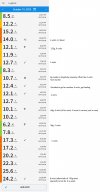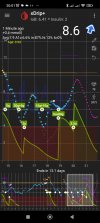Gardevoir
Well-Known Member
- Messages
- 51
- Type of diabetes
- Type 1
- Treatment type
- Pump
Hi,
For the first ~3 months, I've been doing great with my time in range. I'd hit anywhere from 85 to sometimes 95% pretty much every day.
Despite changing nothing (to my knowledge), for the last ~2 months, I've always been below 35%. Most of the time it lingers at 10-12 mmol/L. During my last appointment with my specialist, she briefly mentioned that there's no need to inject when I'm around 10-12 mmol/L as it's excessive to inject for it but if I'm okay with it, I'm free to do so. I kind of shrugged it off as I realized that this personally my best way of getting rid of that difference, but I've been doing terrible ever since that appointment.
Injecting in the evenings and nights barely do anything. Am I out of my honeymoon phase? I've lowered my ratio to be 1:18 instead of 1:20 for dinner since a few days ago but am considering 1:15. I'd usually go to bed feeling very content at anywhere from 5-8 mmol/L but have for the past 2 months only gone to bed at unpleasant numbers. Take yesterday for example: 10.8, inject and be woken up by my alarm, inject more and notice that even after 1-1,5 hours, I'm sitting at 24.2. Inject 8 units which would usually dump my glucose to around 4, but notice that I'm still on 17.2 7 hours later. Not all nights are this bad; this was 1 of the more difficult nights I've had. What am I supposed to do about this? I'm afraid of injecting many more units and going into a dangerous low.
I carefully count my carbs like I always have. I've always done a very good job at injecting the right amount for my food and I've been very proud of how quickly I picked all of this up as a newly diagnosed T1, but it feels like I've failed and I don't know what health consequences this has.
My glucose eventually becomes stable again in the morning. I inject what I'm used to and watch my sugars stabilize at 7.
My alarms are set to 4.2 - 12.0 mmol/L but I've been thinking of lowering my high alarm to be at 11.0. I don't mind injecting and I love data. I scan anywhere from 10 to 20, sometimes 25 times a day and inject on average 8 times.
Above all else, this very heavily affects my mood negatively. I don't know how to mentally get over it.
Thank you
For the first ~3 months, I've been doing great with my time in range. I'd hit anywhere from 85 to sometimes 95% pretty much every day.
Despite changing nothing (to my knowledge), for the last ~2 months, I've always been below 35%. Most of the time it lingers at 10-12 mmol/L. During my last appointment with my specialist, she briefly mentioned that there's no need to inject when I'm around 10-12 mmol/L as it's excessive to inject for it but if I'm okay with it, I'm free to do so. I kind of shrugged it off as I realized that this personally my best way of getting rid of that difference, but I've been doing terrible ever since that appointment.
Injecting in the evenings and nights barely do anything. Am I out of my honeymoon phase? I've lowered my ratio to be 1:18 instead of 1:20 for dinner since a few days ago but am considering 1:15. I'd usually go to bed feeling very content at anywhere from 5-8 mmol/L but have for the past 2 months only gone to bed at unpleasant numbers. Take yesterday for example: 10.8, inject and be woken up by my alarm, inject more and notice that even after 1-1,5 hours, I'm sitting at 24.2. Inject 8 units which would usually dump my glucose to around 4, but notice that I'm still on 17.2 7 hours later. Not all nights are this bad; this was 1 of the more difficult nights I've had. What am I supposed to do about this? I'm afraid of injecting many more units and going into a dangerous low.
I carefully count my carbs like I always have. I've always done a very good job at injecting the right amount for my food and I've been very proud of how quickly I picked all of this up as a newly diagnosed T1, but it feels like I've failed and I don't know what health consequences this has.
My glucose eventually becomes stable again in the morning. I inject what I'm used to and watch my sugars stabilize at 7.
My alarms are set to 4.2 - 12.0 mmol/L but I've been thinking of lowering my high alarm to be at 11.0. I don't mind injecting and I love data. I scan anywhere from 10 to 20, sometimes 25 times a day and inject on average 8 times.
Above all else, this very heavily affects my mood negatively. I don't know how to mentally get over it.
Thank you






